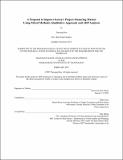A Proposal to Improve Korea’s Project Financing Market Using Mixed Methods: Qualitative Approach and AHP Analysis
Author(s)
Kim, Taeyong
DownloadThesis PDF (1.343Mb)
Advisor
Saiz, Albert
Terms of use
Metadata
Show full item recordAbstract
The real estate finance industry is exposed to various risks due to its diverse economic factors. As such, project financing (PF), relying on the future cash flow from an asset, can play a positive role to diversify risk. As in other markets around the world, the PF market in South Korea has expanded over the last decade. However, concerns over PF risks have recently surged in the face of the crisis in the real estate market because of rising interest rates and increasing material costs.
Insolvency problems in PF have received attention in Korea since the Asian Financial Crisis of 1997 and the Global Financial Crisis of 2008. There are several key factors causing insolvency problems in the Korean PF markets. First, most development projects use the presale method, in which the prepayments from the buyers are used to cover development expenses. Second, credit enhancements from general contractors have been overused and distribution of risk by market participants has remained misaligned. Third, most developers are undercapitalized and use excessive leverage. Fourth, there are issues with the project evaluation systems in terms of professionalism, dependability, and openness. These factors underlie the potential risks that could adversely affect the stability of the financial system.
This study aims to examine and suggest practical ways to improve the stability of the Korean PF market. To this end, the research exploits qualitative and quantitative research methods.
In the initial qualitative research section, the study uses a review of the relevant literature and case studies. Specifically, it investigates the primary PF issues associated with “Policy”, “Risk Sharing Structure”, “Developers”, and “Project Evaluation System”. In addition, the thesis further proposes four improvement plans: first, “Enhancing the Institutional and Policy Framework”; second, “Activating Risk-sharing Structures”; third, “Improving the Capacity of Developers”; and fourth, “Transforming the Project Evaluation System”. These four measures are classified as high-level improvement plans, and each plan is further divided into three subplans (low-level). Thus, we propose twelve (4*3) proposals to improve the system in total.
Next, in the quantitative research part, an Analytic Hierarchy Process (AHP) analysis is applied to evaluate the relative importance of each of the improvement plans and to determine the priorities of real estate PF participants, who were divided into four groups: “Developers”, “General Contractors”, “Financial Institutions”, and “Other Groups”. Surveys were distributed to 60 experts from across these groups.
The results revealed that among the high-level classification of proposed industry improvement plans, “Enhancing the Institutional and Policy Framework” was the most important and “Improving the Capacity of Developers” was the second most important. At lower levels of classification, the importance of each plan was ranked in the following order: “Limiting Credit Enhancement Measures of General Contractors”, “Strengthening Risk Management System and Regulatory Measures”, and “Increasing Participation of Financial Investor (FI) in PF Market.” The results further show that the ranking of importance for the different reforms varied among the different stakeholder groups. Based on these findings, this study discusses how to improve the Korean PF market and suggests that further qualitative research is needed to find a compromise and reconcile the differing perspectives of its stakeholders.
The contribution of this study is that it identifies the fundamental problems of the PF market in Korea and proposes practical plans for reform. Additionally, by determining the priorities among them, it offers valuable data to guide the direction for the future development of this market.
Date issued
2023-02Department
Massachusetts Institute of Technology. Center for Real Estate. Program in Real Estate Development.Publisher
Massachusetts Institute of Technology